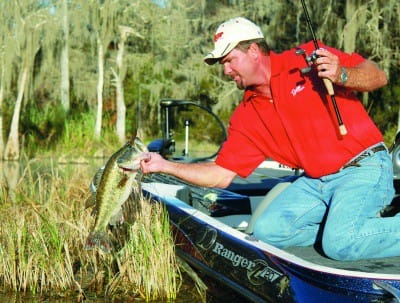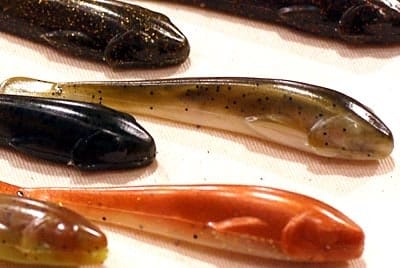Submitted By:
Randy Howell – USA Guest Author
 Sometimes, you just never know what’s going to be on the other end of the line when you reel it in. On most days, that can be a pretty fun prospect – especially in a place you don’t fish a lot. At times, it was that way when I was on Lake Erie, bobbing up and down on big wave after big wave, fishing for some of those giant smallmouth bass they have up there.
Sometimes, you just never know what’s going to be on the other end of the line when you reel it in. On most days, that can be a pretty fun prospect – especially in a place you don’t fish a lot. At times, it was that way when I was on Lake Erie, bobbing up and down on big wave after big wave, fishing for some of those giant smallmouth bass they have up there.
My friends at Berkley were nice enough to give me some new Berkley Gulp! baits to try on the Erie smallmouth. Since the other Gulp! baits work so well on smallies, I couldn’t turn down the opportunity to try them. The new Gulp! Goby didn’t disappoint: I (and a whole bunch of other pros) caught giant smallmouth like crazy. But every now and then, I would hook a fish on a drop shot or Texas-rigged goby that wasn’t a brown bass. Believe it or not, I was catching other gobies. The bait was so powerful, it turned them into cannibals!
Being a southern man, I cut my teeth on largemouth bass fishing. I am always looking for something new to show the bass back home or elsewhere on the tour. Since the goby problem is more or less confined to the Great Lakes region, I am pretty sure a southern largemouth has never seen a goby. But, there are plenty of other reasons that I will be keeping the Gulp! Goby in my boat when we go south.
First, for those who are unfamiliar with the species, a little background on the goby. From the things I’ve heard and read, the goby is an invasive species that was introduced into the Great Lakes region through contaminated ballast water from transoceanic ships. In the time since the introduction, that species has thrived and – unfortunately – spread because they are aggressive, voracious feeders which can forage in total darkness. In Erie, they quickly became a go-to food source for the giant smallmouth there. The worst thing about a goby is that it takes over prime spawning sites traditionally used by native species, competing with native fish for habitat and changing the balance of the ecosystem. Goby can also survive in degraded water conditions, and spawn more often and over a longer period than native fish. Once they are there, they are hard to get rid of.
But predator fish love them, and capitalizing on a fish’s penchant for gobies can work pretty much anywhere.
When fishing with Gulp!, the scent dispersion and flavor are so powerful that species of fish all over the world are being caught with it. We use saltwater baits in freshwater and vice versa, when the conditions warrant. So I’ve learned that just because a species of prey doesn’t exist in a certain fishery that bass in the water won’t eat a bait representing that species. They recognize baits as either a food source or not a food source. Gulp! smells like food to them, they don’t know that gobies are only found in the Great Lakes or that shrimp are from saltwater.
If it’s not the smell and taste of the Gulp! Goby that entices a bass to eat, it could very well be the shape. The shape of the Gulp! Goby – though it perfectly mimics the species – also resembles many of the bait shapes already used for largemouth fishing. Research has shown that it’s not the appendages and the realistic facial features that get s bass to eat, it’s the shape. The Gulp! Goby shape, for the most part, is an elongated, tube-shaped body. To me, more than anything, it looks like a baby catfish. I know at home I’ve caught many largemouth bass with baby catfish in their mouths. They must be easy to catch or something, because the bass love them.

Also, in other areas, the Gulp! Goby can resemble a mud puppy or some kind of water amphibian that inhabits just about every freshwater lake in the country. Bass love this kind of prey.
So, as you can see, the Gulp! Goby is more than just a northern smallmouth bait. But, once you’ve hit your favorite largemouth honey hole down south, how are you going to use it help you catch more fish? That’s easy: do what we do with them on Erie – drop shot.
The drop shot is pretty much standard equipment for any pro on any lake at any time of the year. If you aren’t using a drop shot at least some of the time, there’s a lot of fish that you are missing out on. To drop shot a goby, I use a spinning reel spooled with 10-pound Berkley FireLine tied to a swivel. From the swivel, I tie 8- to 12-pound Berkley Trilene 100% Fluorocarbon line. This new Trilene 100% Fluorocarbon is great line that is super manageable and very sensitive – a must for a drop shot. The swivel keeps the line from twisting. On the fluorocarbon line, I tie a size 3 wide-gap hook with a ¼- to 3/8-ounce drop shot weight below the green pumpkin-colored bait. I vary the distance between the bait and weight based on a variety of conditions; I vary the weight size depending on water depth and wind. Deeper water and higher winds call for heavier weights.
I can fish this rig straight down in deep water or cast it over shoals and points with equal success. And because the goby is made of Gulp!, the slower I fish it, the more scent fills up the area. By the time the largemouth smell this bait, they don’t care what shape the bait is in.
Another good technique for catching largemouth on the Gulp! Goby is flipping timber and boat docks. Using a 3/0 hook on 20-pound Trilene 100% Fluorocarbon, Texas rig the goby and flip it like any other bait. If the fish are held underneath the dock, this plays right into the strength of the Gulp! Goby.
Because of its flat-belly design, the Gulp! Goby is great for skipping under docks. I like to use 10-pound FireLine on a spinning reel and flip the goby with a light weight underneath the docks. It skips great and gets back to the areas that hold big bass on sunny days. With a green pumpkin color, bass will mistake the goby for a sunfish or a small catfish or any of the other prey fish they gorge on back there. If the don’t catch the bait on the fall, the scent dispersion will expand the strike zone – a plus when fishing shallow, dingy water – drawing in bass that otherwise won’t strike a bait they don’t see.
For ages, fishing has been a very regionalized activity, with subtle variations on how to catch fish more or less confined to certain areas. Now, what used to be an old way of catching bass in far-off places is now the new way to catch bass somewhere else. The same thing goes with the goby. It’s been catching smallmouth bass for years, but with the new Gulp! Goby, we can also target largemouth and be equally successful.



